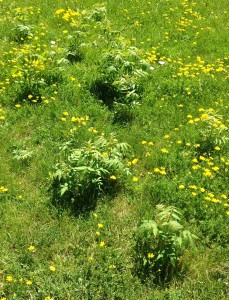 Yes, this is my “lawn”
Yes, this is my “lawn”
I’m all for wildflowers in the summertime but when I notice a grove of sapling sumac taking root in my yard, I realize that I have to take action.
Yes folks, this is my front yard. Not a traditional lawn, but rather a wildflower field that I keep reasonably well cropped. Admittedly, it doesn’t match the manicured estate lots lining our street, but as long as I keep it cut, I figure I can keep the creeping wildflowers that I love so much. I love their colours, their bursts of loveliness popping up all over. Dandelions, Forget-Me-Nots, Maiden Pink and these delightfully yellow two-petal droplets called Birdfoot Trefoil. Nature put them here – and who am I to argue with nature?
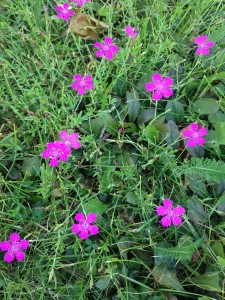
But the sumac are another matter. Sumac do not stay close to the ground and these saplings have grown tall so quickly that they will soon become a grove of unruly trees unless I intervene. Reluctantly, I pull on my work boots and leather gloves, grab a pitchfork and head into the yard.
This work isn’t easy. The ground is clay and the heat and dryness of high summer leave it rock-hard and intractable. Extraction of plants requires patience, delicacy, strength and tenacity, a willingness to try and try again. If I pull at a sapling, it gives way with little fight making it seem as though the work of removing it is easily accomplished. But that’s a mistake – one of nature’s clever little tricks. Digging down a few inches reveals tough roots running laterally underground. As I follow them, I realize that these sumac are not independent relations but rather siblings joined at a series of hips. Their surface weakness is a sly adaptation that increases the likelihood of sumac survival – snapping off above leaves the tough roots intact below, intact and free to propagate.
I place my pitch fork carefully and then thrust it into the ground with all the force I can muster. I lift a mound of dirt and gently free the sapling while trying not to break the roots. It’s touchy work. The earth is so unforgiving that the roots repeatedly snap and disappear. At one point, I even break my pitchfork (and am grateful I have a second).
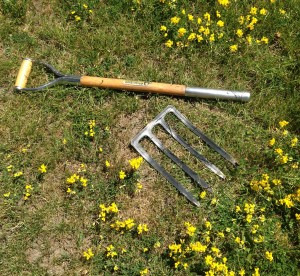
Occasionally, I dig a trench in the right spot, pull the roots up at just the right angle, and am rewarded with a length that gives way smoothly and easily. Every few feet another sapling springs forth.
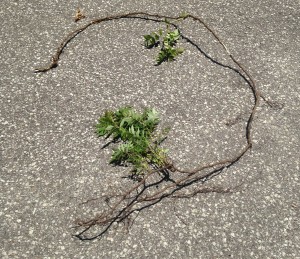
Holding a length of sumac in my hands, I am struck at how these roots and shoots mirror certain aspects of our emotional lives, how what seems like a small thing on the surface might well have long-running roots. Consider how a pop-up sumac might be a little like snapping at a loved one, or a sudden sadness or a recurring irritation. There’s a certain brand of repetitive mood and behaviour that operates the same way – there’s an undercurrent that’s worth excavating. If we simply choke the issue off at the surface, it won’t disappear for long, but will pop back up later, sometimes with greater force. No amount of potato chips, or rum-and-coke, or workaholism — or whatever your choice of distraction– will help in the longer run. The same stuff will just keeping popping up in different places like these sumac, and in my experience, those pop-ups may get progressively bigger and more damaging unless you address the underlying issue.
The work required in excavating our emotions is remarkably similar, requiring gentleness, patience and tenacity. But it’s worth it, worth the effort and the inevitable patching.
Yes, patching. Healing. Restoring balance. Whatever you would like to call it.
Because pulling up the roots also tears up the lawn.
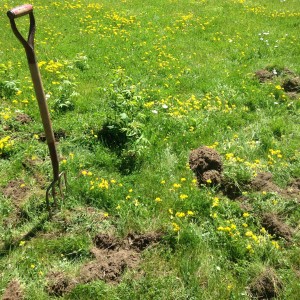
When I’m done the work of removing the roots, the yard looks like a mole field in spring time dotted with holes, small trenches and mounds of dirt. I fill the gaps with fresh soil, pat the surface into quasi-smoothness and lay on the sprinklers in the hope that will help everything will settle back into sumac-free normalcy. Tomorrow, I’ll walk out to this mended patch and check in. In ordinary life, it’s the same way. There’s the initial relief that comes with insight and understanding, and then there’s the ongoing work of restoration, of paying attention, tending the soft spots and loving oneself and others as best we can. And that’s a life’s work.
For over twenty years I’ve lived on this patch of land and this is the first time I’ve had a crop of sumac suddenly pop up in the lawn. It’s a surprise, but not unexpected. Every year brings some new beauty and some fresh challenge. Next year it will be something else. I’ll have my pitchfork ready.